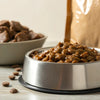Is Wet Dog Food Good for Our Furry Friends? Understanding the Benefits and Drawbacks
- Houndsy
Table of Contents
- Introduction
- What is Wet Dog Food?
- Dry Dog Food Explained
- Benefits of Wet Dog Food
- Drawbacks of Wet Dog Food
- Should We Mix Wet and Dry Dog Food?
- Choosing the Right Wet Dog Food
- Conclusion
Introduction
As devoted pet parents, we often find ourselves questioning the best dietary options for our furry companions. Did you know that approximately 60% of dog owners prefer dry food over wet food? This statistic, while influential, raises various questions worth exploring. One key question that arises is: is wet dog food good for our pets?
Understanding the nutritional value of our dogs’ diets is paramount, as it directly influences their health and happiness. In this blog post, we aim to dissect the pros and cons of wet dog food, shedding light on why it might be a good option for some dogs, and where it may fall short for others. We will discuss wet and dry dog food, including the processing of each type, the benefits and drawbacks of feeding wet dog food, and guidance on mixing both varieties to create a balanced diet.
By the end of this article, we hope to empower you as informed pet owners to make the best dietary choices for your pets, enhancing their well-being and transforming their feeding experience into a joyful ritual. Let’s embark on this journey together and explore whether wet dog food is worth incorporating into our beloved dogs' meals!
What is Wet Dog Food?
Wet dog food, typically found in cans or pouches, is distinguished by its high moisture content, often reaching up to 78%. This moisture-rich food can enhance your dog's eating experience through appealing flavors, textures, and aromas that attract even the pickiest eaters. Unlike dry kibble, which is processed into pellets, wet dog food is cooked and preserved in a way that maintains its moisture and flavor.
Understanding the production of wet dog food offers insight into its benefits and potential drawbacks. The manufacturing process often begins with grinding protein sources, followed by mixing in vitamins, minerals, and grains. This mixture is then cooked and sealed in cans or pouches to preserve its nutritional integrity and flavor. Though it may require more storage and handling than dry food, its palatability and aroma make it a tempting choice for many dogs.
Dry Dog Food Explained
Conversely, dry dog food, or kibble, contains significantly less moisture—usually around 10%. The process for creating kibble involves mixing ingredients to form a dough-like consistency, which is subsequently brewed, dried, and baked into those familiar crunchy nuggets. This type of food is often favored for its convenience; it can be easily portioned, stored without refrigeration, and left out for longer periods without spoiling.
In discussing both types of food, we can see that they serve different purposes and address various dietary needs. The question remains: which is better for our dogs? As we delve deeper into the merits of wet dog food, we can better assess its role in your dog's diet.
Benefits of Wet Dog Food
Hydration Helper
One of the major advantages of wet dog food is its high moisture content. Proper hydration is crucial for maintaining your dog's overall health. Dogs that do not consume enough water may benefit significantly from wet food, particularly those with conditions that necessitate increased fluid intake, such as kidney disease or urinary tract issues. Feeding wet dog food can help supplement your pooch's hydration levels, thereby promoting better organ function and overall health.
Enhanced Palatability
For many dogs, wet food is more appealing than dry kibble. Its stronger aroma attracts even the fussiest eaters, making mealtime an enjoyable experience. This is particularly beneficial for senior dogs or those experiencing temporary loss of appetite due to illness. By offering varied tastes and textures, wet food can stimulate your dog's interest in eating, making it easier to ensure they receive the nutrition they need.
Nutritional Benefits
In general, wet dog food tends to have a higher protein content compared to dry food. Many wet food formulas prioritize quality sources of meat or fish, contributing essential amino acids necessary for bodily functions. Additionally, wet food usually contains lower carbohydrate levels, making it a good option for pets needing to maintain weight or those prone to obesity.
Ease of Consumption
Wet dog food is gentler on your dog's teeth and jaws compared to kibble. This is particularly beneficial for puppies, older pets, or dogs with dental problems. The softer texture allows these dogs to chew easily, ensuring they can enjoy their meals without discomfort.
Drawbacks of Wet Dog Food
Higher Cost
One unavoidable downside to wet dog food is the price point. Wet food can be significantly more expensive compared to kibble, particularly if your dog requires a considerable amount. For dog owners feeding multiple pets or those on a strict budget, this can be a deterrent.
Shorter Shelf Life
Once opened, wet dog food requires refrigeration and should be consumed within three to five days to avoid spoilage. This added care can pose challenges for busy pet owners or dogs that prefer to snack throughout the day. In addition to the risk of spoilage, the packaging often generates more waste compared to dry food bags.
Limited Dental Benefits
Though wet food is easier to chew, it lacks the dental health benefits associated with dry food. The abrasive texture of kibble promotes chewing, potentially reducing tartar buildup and plaque over time. Therefore, dogs fed exclusively wet food may experience dental issues if their oral hygiene needs are not properly addressed.
Potential Health Concerns
Some wet dog foods may contain high levels of fat, which are not suitable for dogs prone to conditions like pancreatitis or obesity. Additionally, some brands may use can linings that contain preservatives such as Bisphenol A (BPA), which is controversial regarding potential health impacts. Owners should always check labels and, when in doubt, consult with a veterinarian regarding the brand of wet food they choose.
Should We Mix Wet and Dry Dog Food?
A popular solution among pet owners is to combine wet and dry dog food. This method allows you to enjoy the benefits of both food types while mitigating some drawbacks.
Benefits of Mixing
- Improved Taste and Aroma: Combining wet food with kibble can enhance the flavor and aroma, making mealtime more enticing.
- Enhanced Hydration: The inclusion of wet food increases moisture intake without compromising the convenience of dry food.
- Variety of Textures: Mixing the two food types exposes pets to different textures and flavors, encouraging healthy eating habits.
- Customizable Nutrition: This blending approach affords pet parents the opportunity to satisfy specific dietary needs, such as weight management or hydration requirements.
Considerations for Mixing Foods
When incorporating both food types, it’s essential to work closely with your veterinarian to determine proper portions. This safeguards against overfeeding and ensures that calorie intake remains balanced. The general guideline is to maintain caloric consistency while adjusting the proportions of each food type based on your dog's needs.
A practical approach is to start slowly—gradually blending wet food into your dog's kibble, allowing them time to adapt to the changes. This transitional period is crucial for avoiding potential digestive upsets.
Choosing the Right Wet Dog Food
Ingredient Quality
When selecting wet dog food, scrutinize the ingredient list. High-quality brands will prioritize real meat, vegetables, and whole food components over fillers or artificial additives. Look for recognizable ingredients, avoiding those with vague terms like "meat by-products."
Nutritional Analysis
Refer to the Guaranteed Analysis section on the packaging to assess the nutritional content, including protein, fat, fiber, and moisture levels. Strive for a balance that aligns with your dog’s lifestyle and health needs. Portions should be adjusted according to your dog's size, age, and activity levels, with a veterinarian’s input.
Conclusion
In conclusion, the question of is wet dog food good is contingent upon your dog's unique needs and lifestyle. While wet dog food certainly provides benefits—enhanced hydration, palatability, and ease of consumption—it’s essential to weigh its drawbacks against dry food. By considering your dog’s healthcare needs, preferences, and your lifestyle, you can make more informed decisions on their diet.
Ultimately, mixing wet and dry food may provide a balanced solution that caters to the varying nutritional requirements of your furry friend. Whether you choose to incorporate wet food entirely or combine both types, what matters most is ensuring a nutritious diet conducive to your dog’s health and happiness.
As we at Houndsy emphasize convenience, quality, and design excellence in our pursuit to create a seamless feeding experience, consider exploring our flagship product, the Houndsy Kibble Dispenser, designed to make your pet feeding routine more enjoyable and efficient.
FAQ
Is wet dog food more nutritious than dry dog food?
Both wet and dry dog foods can be nutritionally balanced. It ultimately depends on the specific brand and formulation. Wet food often has higher protein content and lower carbohydrates.
Can wet dog food be fed exclusively?
While wet food can provide complete nutrition, it's essential to ensure it's suitable for your dog's individual health needs and lifestyle. Consulting with a veterinarian is advisable.
How can I transition my dog to wet food?
Gradually introduce wet food over 7-10 days, mixing it with their current kibble to ease the transition. This prevents digestive issues that can occur with sudden diet changes.
Does wet dog food spoil quickly?
Yes, once opened, it should not be left out for more than 30 minutes. Unused portions should be refrigerated and consumed within three to five days.
Can I mix wet and dry dog food?
Absolutely! Blending both can enhance palatability, increase moisture intake, and provide nutritional variety, but be sure to consult your veterinarian for portion guidance.












